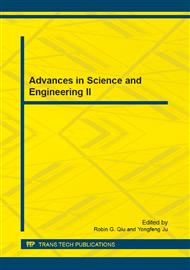[1]
Behzad Kamgar-Parsi and Behrooz Kamgar-Parsi, Vehicle localization on gravity maps, Proc. SPIE Conf. on Unmanned Vehicle Technology, vol. 3693, p.182~191, (1999).
DOI: 10.1117/12.354447
Google Scholar
[2]
Garner C. B, Gravitational field maps and navigational errors, IEEE JOURNAL of OCEANIC ENGINEERING, vol. 27, p.726~737, (2002).
DOI: 10.1109/joe.2002.1040954
Google Scholar
[3]
Xu D X, Using gravity anomaly matching techniques to implement submarine navigation, Chinese J. Geophys. (in Chinese), vol. 48 (4), p.812~816, (2005).
DOI: 10.1002/cjg2.727
Google Scholar
[4]
Peng F Q, Geomagnetic model and geomagnetic navigation, Hydrographic surveying and charting, vol. 26, p.73~75, (2006).
Google Scholar
[5]
Xu S Z, Zhang X D, and Zhang C D, Several problems of underwater magnetic location, Journal of Dalian Naval Academy, vol. 30, p.4~6, (2007).
Google Scholar
[6]
Hao Y L, Zhao Y F, and Hu J F, Preliminary analysis on the application of geomagnetic field matching in underwater vehicle navigation, Process in Geophysics, vol. 23, p.594~598, (2008).
Google Scholar
[7]
Xu S Z, The integral-iteration method for continuation of potential fields, Chinese J. Geophys. (in Chinese), vol. 49, p.1176~1182, (2006).
DOI: 10.1002/cjg2.928
Google Scholar
[8]
Xu S Z, A comparison of effects between the iteration method and FFT for downward continuation of potential fields, Chinese J. Geophys. (in Chinese), vol. 50 p.285~289, (2007).
DOI: 10.1002/cjg2.1032
Google Scholar
[9]
Fedi M and Florio G, A stable downward continuatoin for potential-field anomaly enhancement, Geophys.J. Int, vol. 151, p.146~156, (2002).
Google Scholar
[10]
Wang X T, Xia Z R, Shi P, et al, A comparison of different downward continuation methods for airborne gravity data, Chinese J . Geophys. (in Chinese), vol. 47, p.1017~1022, (2004).
DOI: 10.1002/cjg2.599
Google Scholar
[11]
Liu D J, Hong T Q, and Jia Z H, et al, Wave number domain iteration method for downward continuation of potential fields and its convergence, Chinese J . Geophys. (in Chinese), vol. 52, p.1599~1605, (2009).
Google Scholar
[12]
Liang J W, Regularization methods for potential field downward continuation, Chinese J. Geophys. (in Chinese), vol. 32, p.600~608, (1989).
Google Scholar
[13]
Chen S C and Xiao P F, Wavenumber domain generalized inverse algorithm for potential field downward continuation, Chinese J . Geophys. (in Chinese), vol. 50, p.1816~1822, (2007).
DOI: 10.1002/cjg2.1177
Google Scholar
[14]
Hanke M and Hansen P C, Regularization methods for large scale problems, Surv Math Ind, vol. 3, p.253~315, (1993).
Google Scholar
[15]
Engl H W, Discrepancy principles for Tikhonov regularization of ill-posed problems leading to optimal convergence rates, Optim Theory Appl, vol. 52, p.209~215, (1987).
DOI: 10.1007/bf00941281
Google Scholar


